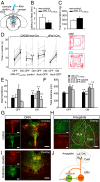Gq/5-HT2c receptor signals activate a local GABAergic inhibitory feedback circuit to modulate serotonergic firing and anxiety in mice
- PMID: 24733892
- PMCID: PMC4035925
- DOI: 10.1073/pnas.1321576111
Gq/5-HT2c receptor signals activate a local GABAergic inhibitory feedback circuit to modulate serotonergic firing and anxiety in mice
Abstract
Serotonin 2c receptors (5-HT2c-Rs) are drug targets for certain mental disorders, including schizophrenia, depression, and anxiety. 5-HT2c-Rs are expressed throughout the brain, making it difficult to link behavioral changes to circuit specific receptor expression. Various 5-HT-Rs, including 5-HT2c-Rs, are found in the dorsal raphe nucleus (DRN); however, the function of 5-HT2c-Rs and their influence on the serotonergic signals mediating mood disorders remain unclear. To investigate the role of 5-HT2c-Rs in the DRN in mice, we developed a melanopsin-based optogenetic probe for activation of Gq signals in cellular domains, where 5-HT2c-Rs are localized. Our results demonstrate that precise temporal control of Gq signals in 5-HT2c-R domains in GABAergic neurons upstream of 5-HT neurons provides negative feedback regulation of serotonergic firing to modulate anxiety-like behavior in mice.
Conflict of interest statement
The authors declare no conflict of interest.
Figures




Similar articles
-
Expression of serotonin 5-HT2C receptors in GABAergic cells of the anterior raphe nuclei.J Chem Neuroanat. 2005 Mar;29(2):83-91. doi: 10.1016/j.jchemneu.2004.03.010. J Chem Neuroanat. 2005. PMID: 15652696
-
Different roles of distinct serotonergic pathways in anxiety-like behavior, antidepressant-like, and anti-impulsive effects.Neuropharmacology. 2020 May 1;167:107703. doi: 10.1016/j.neuropharm.2019.107703. Epub 2019 Jul 9. Neuropharmacology. 2020. PMID: 31299228
-
Dorsal raphe 5-HT(2C) receptor and GABA networks regulate anxiety produced by cocaine withdrawal.Neuropharmacology. 2015 Jun;93:41-51. doi: 10.1016/j.neuropharm.2015.01.021. Epub 2015 Feb 3. Neuropharmacology. 2015. PMID: 25656481 Free PMC article.
-
GABAergic modulation of serotonergic neurons in the dorsal raphe nucleus.Rev Neurosci. 2019 Apr 24;30(3):289-303. doi: 10.1515/revneuro-2018-0014. Rev Neurosci. 2019. PMID: 30173207 Review.
-
Stress-protective neural circuits: not all roads lead through the prefrontal cortex.Stress. 2014 Jan;17(1):1-12. doi: 10.3109/10253890.2013.794450. Epub 2013 Jun 4. Stress. 2014. PMID: 23574145 Review.
Cited by
-
CaMello-XR enables visualization and optogenetic control of Gq/11 signals and receptor trafficking in GPCR-specific domains.Commun Biol. 2019 Feb 14;2:60. doi: 10.1038/s42003-019-0292-y. eCollection 2019. Commun Biol. 2019. PMID: 30793039 Free PMC article.
-
Sensory Ecology of Predator-Induced Phenotypic Plasticity.Front Behav Neurosci. 2019 Jan 18;12:330. doi: 10.3389/fnbeh.2018.00330. eCollection 2018. Front Behav Neurosci. 2019. PMID: 30713490 Free PMC article. Review.
-
Preferential modulation of the lateral habenula activity by serotonin-2A rather than -2C receptors: Electrophysiological and neuroanatomical evidence.CNS Neurosci Ther. 2018 Aug;24(8):721-733. doi: 10.1111/cns.12830. Epub 2018 Feb 25. CNS Neurosci Ther. 2018. PMID: 29479825 Free PMC article.
-
Agomelatine for the treatment of generalized anxiety disorder: focus on its distinctive mechanism of action.Ther Adv Psychopharmacol. 2022 Jun 30;12:20451253221105128. doi: 10.1177/20451253221105128. eCollection 2022. Ther Adv Psychopharmacol. 2022. PMID: 35795687 Free PMC article. Review.
-
The Impact of Neurotransmitters on the Neurobiology of Neurodegenerative Diseases.Int J Mol Sci. 2023 Oct 19;24(20):15340. doi: 10.3390/ijms242015340. Int J Mol Sci. 2023. PMID: 37895020 Free PMC article. Review.
References
-
- Lowry CA, Johnson PL, Hay-Schmidt A, Mikkelsen J, Shekhar A. Modulation of anxiety circuits by serotonergic systems. Stress. 2005;8(4):233–246. - PubMed
-
- Barnes NM, Sharp T. A review of central 5-HT receptors and their function. Neuropharmacology. 1999;38(8):1083–1152. - PubMed
-
- Millan MJ. Serotonin 5-HT2C receptors as a target for the treatment of depressive and anxious states: Focus on novel therapeutic strategies. Therapie. 2005;60(5):441–460. - PubMed
-
- Sharp T, Boothman L, Raley J, Quérée P. Important messages in the “post”: Recent discoveries in 5-HT neurone feedback control. Trends Pharmacol Sci. 2007;28(12):629–636. - PubMed
-
- Sanders-Bush E, Burris KD, Knoth K. Lysergic acid diethylamide and 2,5-dimethoxy-4-methylamphetamine are partial agonists at serotonin receptors linked to phosphoinositide hydrolysis. J Pharmacol Exp Ther. 1988;246(3):924–928. - PubMed
Publication types
MeSH terms
Substances
Grants and funding
LinkOut - more resources
Full Text Sources
Other Literature Sources
Medical
Molecular Biology Databases

